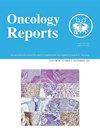The role of ferroptosis in radiotherapy and combination therapy for head and neck squamous cell carcinoma (Review).
IF 3.8
3区 医学
Q2 ONCOLOGY
引用次数: 0
Abstract
Head and neck squamous cell carcinoma (HNSCC) is a highly aggressive, heterogeneous tumour usually caused by alcohol and tobacco consumption, making it one of the most common malignancies worldwide. Despite the fact that various therapeutic approaches such as surgery, radiation therapy (RT), chemotherapy (CT) and targeted therapy have been widely used for HNSCC in recent years, its recurrence rate and mortality rate remain high. RT is the standard treatment choice for HNSCC, which induces reactive oxygen species production and causes oxidative stress, ultimately leading to tumour cell death. CT is a widely recognized form of cancer treatment that treats a variety of cancers by eliminating cancer cells and preventing them from reproducing. Immune checkpoint inhibitor and epidermal growth factor receptor are important in the treatment of recurrent or metastatic HNSCC. Iron death, a type of cell death regulated by peroxidative damage to phospholipids containing polyunsaturated fatty acids in cell membranes, has been found to be a relevant death response triggered by tumour RT in recent years. In the present review, an overview of the current knowledge on RT and combination therapy and iron death in HNSCC was provided, the mechanisms by which RT induces iron death in tumour cells were summarized, and therapeutic strategies to target iron death in HNSCC were explored. The current review provided important information for future studies of iron death in the treatment of HNSCC.头颈部鳞状细胞癌的放疗和综合疗法中铁细胞增多症的作用(综述)。
头颈部鳞状细胞癌(HNSCC)是一种侵袭性极强的异质性肿瘤,通常由饮酒和吸烟引起,是全球最常见的恶性肿瘤之一。尽管近年来手术、放射治疗(RT)、化疗(CT)和靶向治疗等各种治疗方法已广泛应用于 HNSCC,但其复发率和死亡率仍然居高不下。RT 是 HNSCC 的标准治疗选择,它会诱导活性氧的产生并导致氧化应激,最终导致肿瘤细胞死亡。CT 是一种被广泛认可的癌症治疗方式,它通过消除癌细胞并阻止其繁殖来治疗各种癌症。免疫检查点抑制剂和表皮生长因子受体是治疗复发性或转移性 HNSCC 的重要药物。铁死是一种由细胞膜中含有多不饱和脂肪酸的磷脂过氧化损伤调控的细胞死亡,近年来已被发现是由肿瘤RT引发的一种相关死亡反应。本综述概述了目前有关 RT 和联合疗法以及 HNSCC 中铁死亡的知识,总结了 RT 诱导肿瘤细胞铁死亡的机制,并探讨了针对 HNSCC 中铁死亡的治疗策略。本综述为今后研究治疗 HNSCC 中的铁死亡提供了重要信息。
本文章由计算机程序翻译,如有差异,请以英文原文为准。
求助全文
约1分钟内获得全文
求助全文
来源期刊

Oncology reports
医学-肿瘤学
CiteScore
8.50
自引率
2.40%
发文量
187
审稿时长
3 months
期刊介绍:
Oncology Reports is a monthly, peer-reviewed journal devoted to the publication of high quality original studies and reviews concerning a broad and comprehensive view of fundamental and applied research in oncology, focusing on carcinogenesis, metastasis and epidemiology.
 求助内容:
求助内容: 应助结果提醒方式:
应助结果提醒方式:


